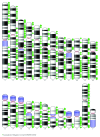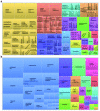Advances in understanding - genetic basis of intellectual disability
- PMID: 27127621
- PMCID: PMC4830215
- DOI: 10.12688/f1000research.7134.1
Advances in understanding - genetic basis of intellectual disability
Abstract
Intellectual disability is the most common developmental disorder characterized by a congenital limitation in intellectual functioning and adaptive behavior. It often co-occurs with other mental conditions like attention deficit/hyperactivity disorder and autism spectrum disorder, and can be part of a malformation syndrome that affects other organs. Considering the heterogeneity of its causes (environmental and genetic), its frequency worldwide varies greatly. This review focuses on known genes underlying (syndromic and non-syndromic) intellectual disability, it provides a succinct analysis of their Gene Ontology, and it suggests the use of transcriptional profiling for the prioritization of candidate genes.
Conflict of interest statement
No competing interests were disclosed.
Figures







References
-
- Maulik PK, Harbour CK: Epidemiology of Intellectual Disability. In: JH Stone, M Blouin, editors. International Encyclopedia of Rehabilitation2010. Reference Source
Publication types
LinkOut - more resources
Full Text Sources
Other Literature Sources

